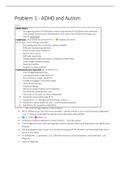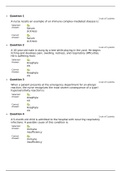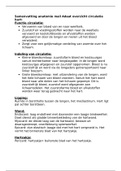Problem 1 - ADHD and Autism
ADHD
ADHD DSM-5
- An ongoing pattern of inattention and/or hyperactivity & impulsivity that interferes
with normal functioning or development, with either one of (these two types can
also be combined):
Inattention ( 6+ of these for at least 6+ m + impacts activities)
For 17y/o+, min 5 of these required
- Not paying attention to details/ careless mistakes
- Difficulty maintaining attention
- Doesn’t listen when spoken to
- Ignores instructions
- Difficulty organizing
- Dislikes/avoids tasks that require sustained mental effort
- Loses things needed for tasks
- Easily distractible
- Forgetful in daily activities
Hyperactivity and Impulsivity (6+ of these 6+m)
- Lots of fidgeting/squirming
- Leaving seat when expected to sit
- Runs/ climbs in inapp. situations
- Unable to engage in activities quietly
- Can’t sit still/restless
- Excessive talking
- Blurts out answer before end of question
- Has difficulty awaiting their turn
- Interrupts or intrudes on others frequently
B. Symptoms there before age of 12
C. Symptoms in 2+ settings/contexts (home, school…)
D. Symptoms reduce quality of educ., soc/occupational ability
E. Symptoms not caused by schiz/other
Prevalence: 5% of school-age children; 2.5% of adults
• 9% of children & ad. (not the most prevalent – specific phobia is, but most frequently diagnosed)
- cuz ↑ likely to be brought by parents (more disruptive than phobia)
• ↑ (13%), (4%) + c-c
• Symptoms mostly recognized in school children – most disruptive
• First recognized when child starts going to school, because learning & adjustment are significantly
affected
• Life-long diagnosis but can go into remission (coping with the disorder, not disrupting daily life as
much or very little)
• As child grows, ↓ symptoms , but 50% will continue to show symptoms into adulthood - can
affect IQ
• Issues in diagnosis
, o Gender differences in diagnosis – differently manifested in girls (more inattention – less
disruptive) and boys (more hyperactive - disruptive)
o Hard to insure whether the hyperactivity is tied to a situation or generalized
o Cultural context
Comorbidity: OCD & CD (Conduct disorder – violation of social norms/basic rights)
- low self-esteem → anxiety and depression
- Impaired executive functions – they do have normal theory of mind
Symptoms: Changeable mood, low self-esteem, bossiness, frustration;
Result: poor academic performance (score lower on tests – cuz of attention), conflict with teachers and
parents, don’t obey rules
• Family – see beh. as intentional and irresponsible → resentment
If mostly inattentive symptoms – worst in academic achievement (6+ inattentive symptoms and less than
6 hyperactive)
If mostly hyperactive/impulsive symptoms – worst in peer rejection and accidental injury (6+ hyperactive
symptoms and less than 6 inattentive)
• Difficulty making friends; failure to understand the intentions of their peers and are unable to
translate the correct social response into appropriate behavior
• In adulthood: ↓ success at work, interpersonal rel, academic outcomes & general life
satisfaction
CAUSES - Bio
• Genetic factors - heritability 76% - most heritable disorder
• Depends both on genetic and environmental potential
• Susceptibility to the disorder is inherited, has to be triggered by the environment
• Part of chromosome 16 has most evidence – dopamine, serotonin, norepinephrine (executive
functioning, inhibition…), ADHD have deficiency of dopamine – seek for rewards in the
environment
• Dopamine transporter gene, D4 & D5 receptors and SNAP-25 (a gene that controls the way
dopamine is released in the brain)
• Children with two copies of 10-repeat allele of a DAT1 gene (regulates the way dopamine is
released in the brain) + maternal prenatal smoking = ↑ risk
Brain
• Smaller brains → predictor of poor inhibition and self-regulation
• +slower development → problems with complex motor movement
• Mostly affected = frontal (↓ volume = ↓ inhibition), parietal, temporal & occipital, basal ganglia,
cerebellum (abnormalities = affects complex motor & cog responses)
• Striatal thalamic cortical circuit → involved with the desire for immediate reward
• ↓ Grey Matter altogether
Prenatal factors
• Maternal smoking & drinking – predicts abnormalities in the dopaminergic system
, • Low birth weight, respiratory distress & birth asphyxia (severely low supply of oxygen to
body that caused by abnormal breathing)
Environmental factors
• ↑ lead in blood
• Chronic exposure to nicotine/tobacco smoke
Psychological
Parent-child interaction
• Parents could be suffering from ADHD as well as it is so highly heritable → more likely to become
irritated
• Inconsistent and ineffective parenting
• Authoritarian parenting: + impatient with child
The attention from the parent may be rewarding/reinforcing
Theory of mind deficits (no)
↓ perfor. on executive functioning, but no strong evidence for poor TOM performance → no deficits in
social functioning!
TREATMENT - Bio
Ritalin (methylphenidate) – an amphetamine quieting effect on children, ↓ overactivity & distractibility +
↑ alertness → at school
Side effects: decreased blood flow to brain = impaired thinking ability & memory loss; disruption of
growth hormone; insomnia; psychosis
Pemoline - school beh. – ↑ cognitive processing, less negative side effects
Strattera - noncontrolled option, ↓ symptoms, but dk how it works
Side effects: decreased appetite, nausea, vomiting, fatigue, liver damage
Adderall – mix of amphetamine & dextro-amphetamine; no advantage over Ritalin & Strattera
Short-term effects of these are known but we dk the long-term ones
Behavioral training = positive reinforcement, structuring of learning materials in a way that minimizes
error and maximizes immediate feedback & success + family therapy
Time-out = positive reinforcement, for reducing aggressiveness, & non-compliance in the classroom
Behaviour management techniques e.g. teaching parents to identify & reward beh
Family therapy = Systemic = problem stem from bad family structure & organization – focus on comm
between child & mom
Parent management training = teach parent sot modify responses =
Functional family therapy = CBT + systemic, strengthens relationships by opening comm between parent
& child
CBT
Play therapy – for younger children
ARTICLE
Aim: To review non-pharmacological interventions for preschoolers, school-age children, adolescents and
adults
Method: meta-analysis of research papers by searching keywords (ADHD, children, parent training etc.)
, Results:
• Preschool children – parent training
o written material about ADHD
o Teach parents behavioral strategies
o Teach techniques to target and monitor problematic behaviors e.g. behavioral diary
o Reward prosocial behaviours through praise, positive attention and tangible rewards
o Decrease unwanted behaviours through planned ignoring, time-out, effective commands
and other similar non-physical disciplinary techniques
o Address parental risk factors (by counselling, support groups)
• Young school-age children
o Parent training – until age 12
▪ Management strategies – e.g. introducing mediating notebooks or diaries to
facilitate teacher–parent communications and the setting and reward of
educational goals-both academic and behavioural
o Classroom interventions
▪ Provision of psychoeducational information – written material that takes into
account the developmental and behavioural needs of the child
▪ use of both verbal and written instructions and avoidance of complex sentences
that involve several concepts
▪ behavioural strategies and techniques to identify and manipulate the
antecedents and consequences of the child’s behaviour
▪ Reward achievements and/or prosocial behaviours through praise, positive
attention and tangible rewards
▪ Decrease unwanted behaviours through planned ignoring, time-out
• Middle/high school children/ adolescents
o Classroom interventions
▪ psychoeducational information, environmental and management strategies as
outlined for young school-age children but with adaptations for this
developmental age group, e.g., use of a Weekly Report Card instead of a Daily
Report Card;
▪ teach study skills, including test-taking strategies; implement homework
completion sessions; reward systems can be extended to introduce longer-term
rewards
▪ regular sessions attended by parents, teachers and counsellors initially to identify
the child’s needs and formulate an intervention plan
▪ Implementation of individualised programmes
o CBT + Social Skills Training
▪ Provision of psychoeducational information
▪ Achievements and improvement can be rewarded
▪ Direct intervention (including role plays) with the child to improve social
communication skills focusing on both specific micro-skills (e.g., appropriate eye
contact, voice volume and tone, body positioning) and macro-skills which involve
more complex interactions (e.g., giving compliments, constructive feedback,
turn-taking, listening skills, conflict resolution, assertion)







